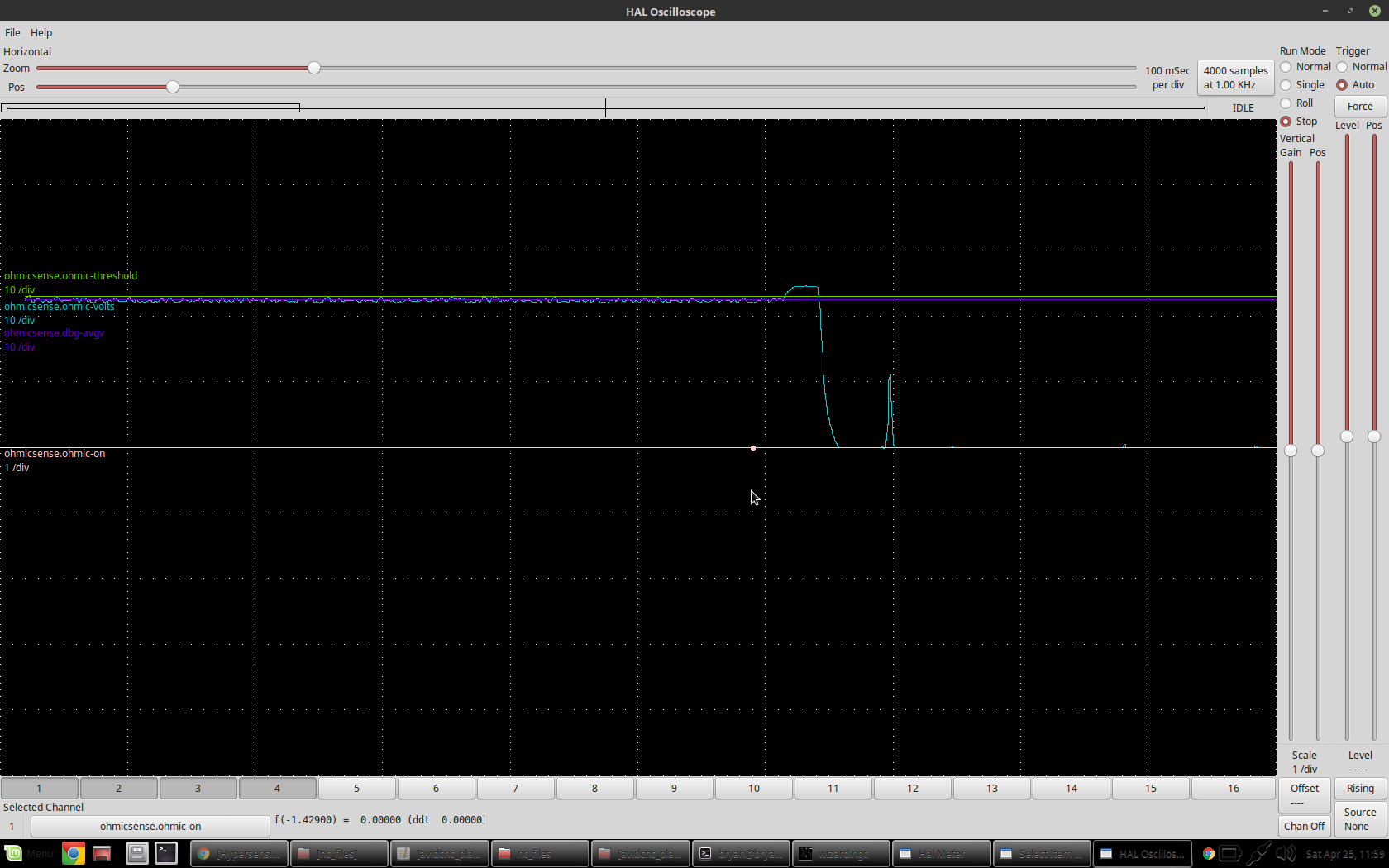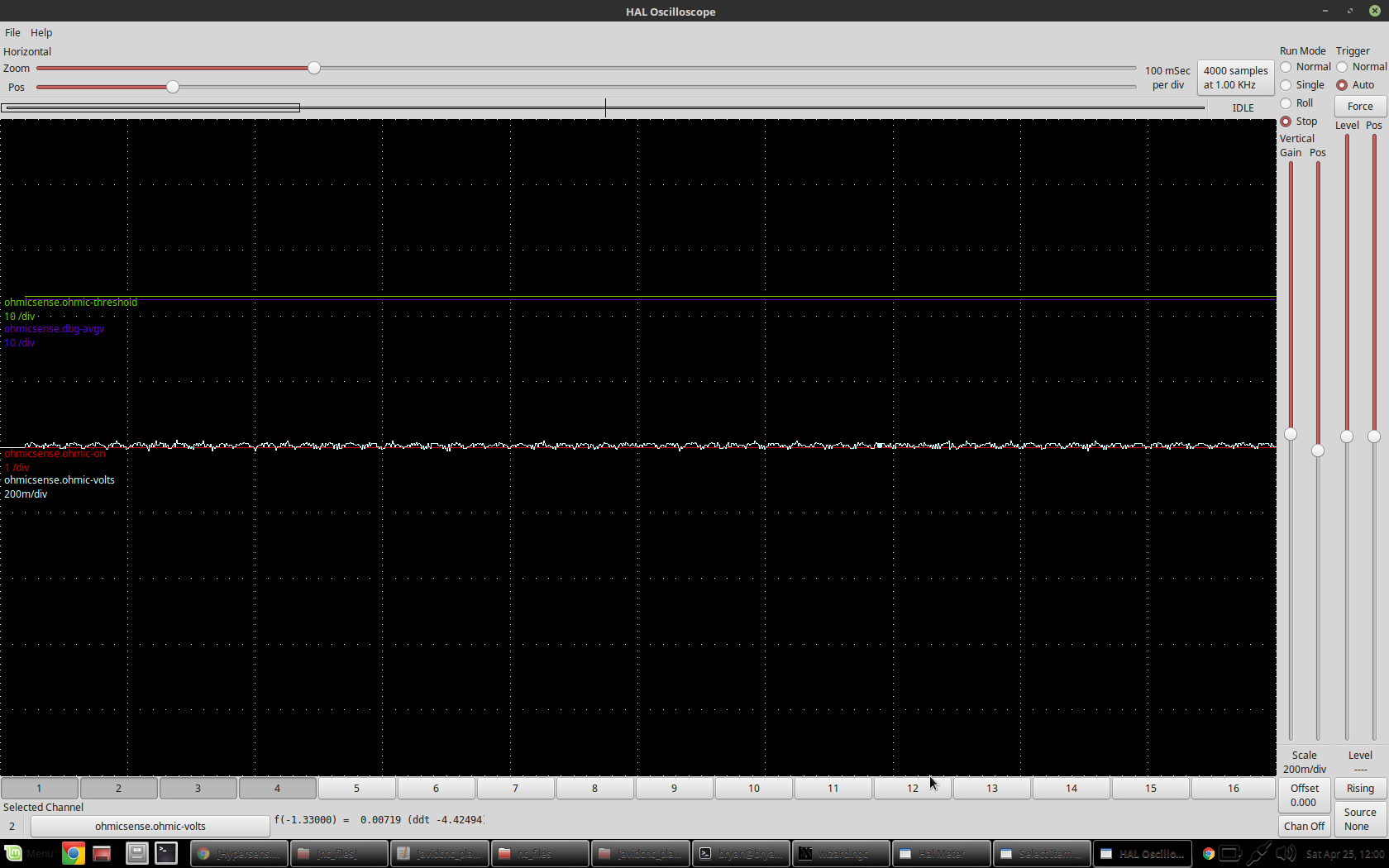Hypersensing questions
- Uthayne
- Offline
- Premium Member
-

Less
More
- Posts: 145
- Thank you received: 46
25 Apr 2020 01:00 #165464
by Uthayne
Replied by Uthayne on topic Hypersensing questions
Consumables are used, probably 50% life left at least though. Copper plus electrode and fine cut nozzle. Ohmic shield.
However I did do a couple of cuts with the standard nozzle/shield and had no problems there either, but didn't record any data
However I did do a couple of cuts with the standard nozzle/shield and had no problems there either, but didn't record any data
The following user(s) said Thank You: rodw
Please Log in or Create an account to join the conversation.
- rodw
-

- Offline
- Platinum Member
-

Less
More
- Posts: 11540
- Thank you received: 3867
25 Apr 2020 01:35 #165466
by rodw
Replied by rodw on topic Hypersensing questions
Consumable condition will have no bearing on this.
The contact is between the shield and the material.
Anything on the electrode side can only affect the noise in the base signal which we have smoothed with the moving average anyway.
The contact is between the shield and the material.
Anything on the electrode side can only affect the noise in the base signal which we have smoothed with the moving average anyway.
Please Log in or Create an account to join the conversation.
- snowgoer540
-
 Topic Author
Topic Author
- Offline
- Moderator
-

Less
More
- Posts: 2513
- Thank you received: 848
25 Apr 2020 01:40 - 25 Apr 2020 01:42 #165469
by snowgoer540
I disagree, the wet torch part of what we are doing is a result of the electricity finding a path to ground via the consumables, the torch wiring, through the plasma cutter, to the ground clamp and to the table... which is why if you have a wet torch and you remove the ground clamp, the volts promptly drop to 0. If the consumables are worn and dirty, that path is harder to travel, and as such likely why Uthayne gets 18 volts with his resistor and I don’t see as big of a drop.
Replied by snowgoer540 on topic Hypersensing questions
Consumable condition will have no bearing on this.
The contact is between the shield and the material.
Anything on the electrode side can only affect the noise in the base signal which we have smoothed with the moving average anyway.
I disagree, the wet torch part of what we are doing is a result of the electricity finding a path to ground via the consumables, the torch wiring, through the plasma cutter, to the ground clamp and to the table... which is why if you have a wet torch and you remove the ground clamp, the volts promptly drop to 0. If the consumables are worn and dirty, that path is harder to travel, and as such likely why Uthayne gets 18 volts with his resistor and I don’t see as big of a drop.
Last edit: 25 Apr 2020 01:42 by snowgoer540.
Please Log in or Create an account to join the conversation.
- snowgoer540
-
 Topic Author
Topic Author
- Offline
- Moderator
-

Less
More
- Posts: 2513
- Thank you received: 848
25 Apr 2020 01:43 #165471
by snowgoer540
I’d be curious what sort of wet torch voltage you see with brand new consumables. And a very wet torch.
That sounds more lewd than I intended. Haha
Replied by snowgoer540 on topic Hypersensing questions
Consumables are used, probably 50% life left at least though. Copper plus electrode and fine cut nozzle. Ohmic shield.
However I did do a couple of cuts with the standard nozzle/shield and had no problems there either, but didn't record any data
I’d be curious what sort of wet torch voltage you see with brand new consumables. And a very wet torch.
That sounds more lewd than I intended. Haha
Please Log in or Create an account to join the conversation.
- snowgoer540
-
 Topic Author
Topic Author
- Offline
- Moderator
-

Less
More
- Posts: 2513
- Thank you received: 848
25 Apr 2020 01:48 #165472
by snowgoer540
Thanks for the glimpse Tom. I certainly appreciate the sentiment about making valuable memories...sometimes it's easy to get caught up in the day to day, and next thing you know it's nearly May and the whole world is shut down and memory creation requires greater creativity.
At any rate, here's to 3076!
Replied by snowgoer540 on topic Hypersensing questions
Here ya go:It occurs to me as I type everyone’s username that maybe am introduction thread isn’t the worst thing (like I always used to think it was).
www.tomberisha.com
Thanks for the glimpse Tom. I certainly appreciate the sentiment about making valuable memories...sometimes it's easy to get caught up in the day to day, and next thing you know it's nearly May and the whole world is shut down and memory creation requires greater creativity.
At any rate, here's to 3076!
The following user(s) said Thank You: tommylight
Please Log in or Create an account to join the conversation.
- rodw
-

- Offline
- Platinum Member
-

Less
More
- Posts: 11540
- Thank you received: 3867
25 Apr 2020 02:04 #165474
by rodw
Replied by rodw on topic Hypersensing questions
But we are not interested in the voltage at idle.
We are only interested in sensing when it rises when there is a good connection with the material by the shield. It should get to 24 volts. The conductivity of the water around the world will vary greatly with the water source and the additive used. Remember that pure water is an insulator, its the dissolved salts and the like that conducts electricity.
We are only interested in sensing when it rises when there is a good connection with the material by the shield. It should get to 24 volts. The conductivity of the water around the world will vary greatly with the water source and the additive used. Remember that pure water is an insulator, its the dissolved salts and the like that conducts electricity.
Please Log in or Create an account to join the conversation.
- snowgoer540
-
 Topic Author
Topic Author
- Offline
- Moderator
-

Less
More
- Posts: 2513
- Thank you received: 848
25 Apr 2020 14:18 #165544
by snowgoer540
I don't understand how you aren't interested in the voltage at idle? if at idle it is spiking just below 23.5v with your threshold at 23.8v and your max at 24v then I would say you're REALLY close to having a problem. Add a little more ionization to the water and you could have a problem where your voltage level trips the probe ... at idle. In which case, it will fail to probe.
Replied by snowgoer540 on topic Hypersensing questions
But we are not interested in the voltage at idle.
We are only interested in sensing when it rises when there is a good connection with the material by the shield. It should get to 24 volts. The conductivity of the water around the world will vary greatly with the water source and the additive used. Remember that pure water is an insulator, its the dissolved salts and the like that conducts electricity.
I don't understand how you aren't interested in the voltage at idle? if at idle it is spiking just below 23.5v with your threshold at 23.8v and your max at 24v then I would say you're REALLY close to having a problem. Add a little more ionization to the water and you could have a problem where your voltage level trips the probe ... at idle. In which case, it will fail to probe.
The following user(s) said Thank You: tommylight
Please Log in or Create an account to join the conversation.
- PCW
-

- Away
- Moderator
-

Less
More
- Posts: 17470
- Thank you received: 5101
25 Apr 2020 14:39 #165545
by PCW
Replied by PCW on topic Hypersensing questions
Hmm.. 24.5V full scale and 23.5V from leakage means that you have about 1K leakage resistance when wet...
Sounds like you have a very high salt concentration in your water or some issue with your torch
Sounds like you have a very high salt concentration in your water or some issue with your torch
Please Log in or Create an account to join the conversation.
- snowgoer540
-
 Topic Author
Topic Author
- Offline
- Moderator
-

Less
More
- Posts: 2513
- Thank you received: 848
25 Apr 2020 15:08 #165547
by snowgoer540
On well water with a water softener, so the salt concentration could be a factor.
Torch is basically brand new, so I wouldnt expect that to be the issue. But like I said, my consumables are all brand new, where Uthayne's are 50% remaining.
It's worst case, so we're still probably in the green. Just reporting back in case it changes any thinking or direction.
Replied by snowgoer540 on topic Hypersensing questions
Hmm.. 24.5V full scale and 23.5V from leakage means that you have about 1K leakage resistance when wet...
Sounds like you have a very high salt concentration in your water or some issue with your torch
On well water with a water softener, so the salt concentration could be a factor.
Torch is basically brand new, so I wouldnt expect that to be the issue. But like I said, my consumables are all brand new, where Uthayne's are 50% remaining.
It's worst case, so we're still probably in the green. Just reporting back in case it changes any thinking or direction.
Please Log in or Create an account to join the conversation.
- Uthayne
- Offline
- Premium Member
-

Less
More
- Posts: 145
- Thank you received: 46
25 Apr 2020 16:13 #165550
by Uthayne
Replied by Uthayne on topic Hypersensing questions
I put a brand new set of consumables in (copper plus electrode and fine cut nozzle). My ohmic shield is the same, I don't have a spare for that.
First I took the torch and soaked it in the water for about 10 seconds, covering up the entire ohmic shield. Pulled it out of the water and it was reading 22-23V, and tripping my ohmic sensor. However, after pulsing the torch for 0.1 seconds, it went right back to 0v.
Then I did a second test where I pulsed the torch to get air flowing with it 1 inch over top the water. I let the air run the entire time and soak the torch. Same thing, 22-23v at idle afterwards. I did another post pulse air flow over steel and it immediately went to 6-7v, and lowered to 1-2 about 10 seconds later.
I agree that ohmic-volts can still hover around 22-23v when the torch is completely soaked, but I haven't been able to not clear it up via pulsing. Before the 22K (sensitivity adj resistor), I would pulse the torch and it still wouldn't clear a really wet torch. It would stay at 22-23v after air turned off. Now I can't seem to replicate it.
In the second picture, I increased the gain on the ohmic-volts signal 50X to show that it is indeed at 0v. 200mV per division instead of 10V.
Can you tell us what happens when you pulse the torch and have air flowing through it? Does it stay at 23v or drop?
First I took the torch and soaked it in the water for about 10 seconds, covering up the entire ohmic shield. Pulled it out of the water and it was reading 22-23V, and tripping my ohmic sensor. However, after pulsing the torch for 0.1 seconds, it went right back to 0v.
Then I did a second test where I pulsed the torch to get air flowing with it 1 inch over top the water. I let the air run the entire time and soak the torch. Same thing, 22-23v at idle afterwards. I did another post pulse air flow over steel and it immediately went to 6-7v, and lowered to 1-2 about 10 seconds later.
I agree that ohmic-volts can still hover around 22-23v when the torch is completely soaked, but I haven't been able to not clear it up via pulsing. Before the 22K (sensitivity adj resistor), I would pulse the torch and it still wouldn't clear a really wet torch. It would stay at 22-23v after air turned off. Now I can't seem to replicate it.
In the second picture, I increased the gain on the ohmic-volts signal 50X to show that it is indeed at 0v. 200mV per division instead of 10V.
Can you tell us what happens when you pulse the torch and have air flowing through it? Does it stay at 23v or drop?
Attachments:
Please Log in or Create an account to join the conversation.
Moderators: snowgoer540
Time to create page: 0.227 seconds


